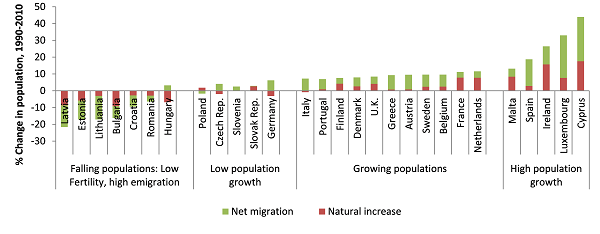Europe is facing the biggest inflow of migrants in decades. The number of refugees from conflict zones in Syria, Iraq, and elsewhere arriving at southern European shores is rising by the day. The resulting surge of asylum claims in the European Union (EU) have exposed divisions between EU member states over how to react. Governments in Central Europe and the Baltics have rejected the proposals by the European Commission to use mandatory quotas to distribute refugees across all 28 member states and come out against taking in significant numbers of refugees.
But wait a minute. Opposition to immigration appears counterintuitive for countries that face the prospect of aging and rapid population declines. For example, the Baltic countries and Bulgaria have already seen their populations shrink by more than 15 percent since 1990, Croatia by 10 percent, and Romania and Hungary by more than 5 percent. The share of the population aged 65 and above in the countries of Central Europe and the Baltics increased by more than a third between 1990 and 2010. Unlike in Western Europe, where people are living longer, aging in Central Europe and the Baltic countries has been driven significant emigration, especially of young people of child-bearing age and often to Western Europe, and by substantial drops in fertility. Fertility rates in Central Europe and the Baltic countries today are generally below 1.6. They are as low as 1.3 in Poland, Hungary, and Slovakia—far below the replacement fertility rate of 2.1. Population projections suggest that aging and demographic decline will continue and even accelerate, putting economic growth at risk and adding to fiscal pressures through a greater reliance on old age pensions and health services.
Figure 1: Low fertility and high emigration have led to falling or stagnating populations in Central Europe and the Baltics
Cumulative population change 1990-2010, in percent

Source: Based on United Nations’ Population Division (2013). Definitions: (i) Natural increase in the population: births minus deaths; (ii) Net migration: total number of immigrants less the number of emigrants.
How can Europe turn this challenge around? Countries can minimize economic and social consequences of demographic change through policies that makes smaller workforces more productive, including through improvements in workers’ skills and health so that they can be employed more productively and during longer working lives. Given the vast size of emigration from countries in Central Europe and the Baltics over the last two decades, immigration will not make up for the decline in working-age populations. But with refugee numbers in Europe surging, immigration will gradually become an element of the policy response. The real policy question for the countries of Central Europe and the Baltics today is therefore not whether to accept migrants or not but, rather, how to turn the challenge of today’s refugee crisis into an opportunity. At a minimum, the examples of Turkey and Jordan show that hosting far larger numbers of refugees than Europe need not be an economic drag.
Given the terrible and intractable conditions in their countries of origin, refugees from Syria, Iraq, and Eritrea arriving in Europe today are likely to stay for a while. This suggests that once short-term humanitarian emergency needs are met, they require stable housing, schooling, health, and employment solutions for the medium term. For example, since large numbers of refugees are coming with children of schooling age, schools need capacity for introductory classes to allow children to learn the language of the host country and to get integrated into general classrooms. Education systems in countries in Central Europe and the Baltics are adjusting to declining student numbers, so there should be infrastructure and teacher capacity to accommodate incoming refugee children and youth.
Many migrants arriving in Europe today come with the skills and motivation to be successful and to make a contribution to their host countries’ economies. Many come with children. They have the potential to not just alleviate declining numbers of workers but also to boost innovation through bringing fresh ideas and perspectives. Integrating migrants is challenging. I can think of plenty of examples across Europe where integration has not been successful. But there are others. Take the example of the Vietnamese community that has been living in the Czech Republic for decades. There are more than 60,000 ethnic Vietnamese in the Czech Republic today—20 times more than the European Commission’s refugee quota would allocate to the country. Many Vietnamese have excelled in education and are active in the business community. Examples of both failure and success of integration provide lessons to inform policy about how to make Europe’s response to the refugee crisis not just an essential humanitarian act but also a smart investment in its economic prosperity.

Commentary
Is the refugee crisis an opportunity for an aging Europe?
September 21, 2015